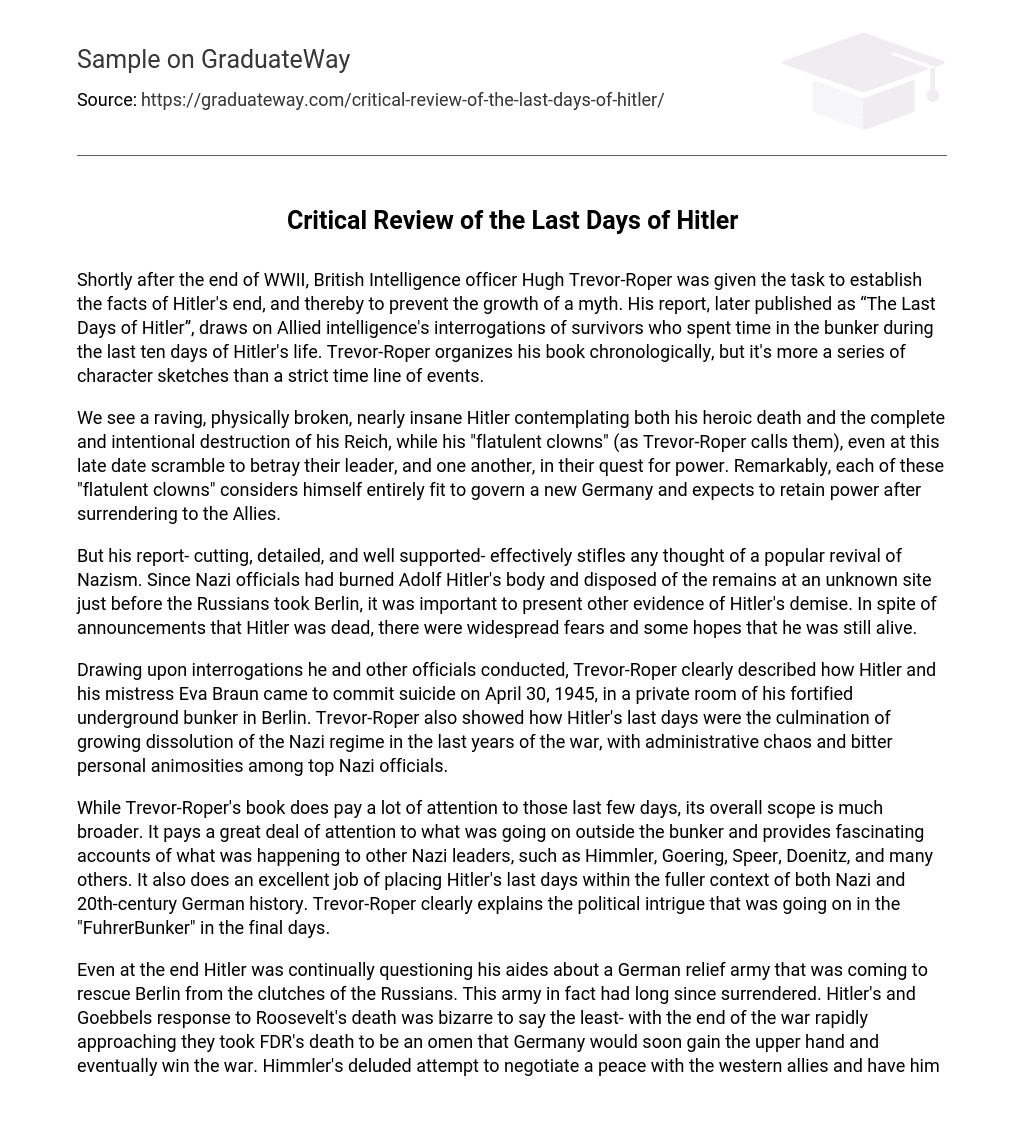In his report “The Last Days of Hitler,” Hugh Trevor-Roper, a British Intelligence officer, was assigned to investigate and uncover the truth about Adolf Hitler’s death post-World War II. The main goal was to prevent any false narratives or myths from emerging. Trevor-Roper’s findings, which were published later on, rely heavily on testimonies from survivors who witnessed the events that occurred in Hitler’s bunker during his last ten days. Although the book presents its findings in chronological order, its primary emphasis lies in portraying the personalities involved rather than offering a rigidly linear narrative.
Hitler, in a state of frenzy and physical deterioration, is contemplating his heroic demise and the intentional destruction of his Reich. Meanwhile, his subordinates, referred to as “flatulent clowns” by Trevor-Roper, continue to betray him and each other as they vie for power. Astonishingly, each of these “flatulent clowns” believes themselves capable of governing a post-war Germany and anticipates retaining authority even after surrendering to the Allies.
However, his comprehensive and well-substantiated report successfully suppresses any notion of a resurgence of Nazism. Given that Nazi officials had incinerated Adolf Hitler’s body and discarded the remains at an undisclosed location shortly before the Russians captured Berlin, it was crucial to offer alternative proof of Hitler’s death. Despite official declarations regarding Hitler’s demise, concerns were widespread, and there were even some individuals holding onto the hope that he might still be alive.
Trevor-Roper detailed the events surrounding Hitler and Eva Braun’s suicide on April 30, 1945, in a private room of their fortified underground bunker in Berlin. Interrogations conducted by Trevor-Roper and other officials provided insight into the culmination of Hitler’s last days, which encompassed the deteriorating Nazi regime during the final years of the war. This included administrative disarray and intense personal hostilities among high-ranking Nazi officials.
In addition to focusing on the last few days, Trevor-Roper’s book also discusses various other topics. It examines the external events surrounding the bunker and presents intriguing accounts of influential Nazi figures such as Himmler, Goering, Speer, Doenitz, and others. Moreover, it effectively situates Hitler’s final days within the broader context of Nazi and 20th-century German history. Trevor-Roper provides concise explanations of the political maneuverings that took place in the “FuhrerBunker” during those concluding days.
Despite the surrender of the German relief army, Hitler persisted in his inquiries until the end in hopes of saving Berlin from the Russians. It is strange how both Hitler and Goebbels reacted to Roosevelt’s death, considering that the war was nearing its conclusion. They viewed FDR’s demise as a sign of Germany’s upcoming dominance and ultimate triumph in the war. Himmler, on the other hand, demonstrated a profound detachment from reality by attempting to negotiate peace with the western allies and assume leadership.
Although many main characters in this book lacked a full grasp of reality, Fegelin, Hitler’s brother-in-law, emerged as one of the few individuals with common sense. Recognizing the seriousness of the situation, he wisely opted to depart from the bunker and return home. Unfortunately, members of Hitler’s guard apprehended him and forcefully brought him back to the bunker, resulting in his eventual execution. It is important to mention that Trevor-Roper relied on these crucial sources to construct a coherent and precise book.
“The Last Days of Hitler” relied on personal interviews and captured documents to accurately depict the events that occurred in the bunker from April 20-29, 1945. Interrogating doctors who treated Hitler helped establish his health and physical state during his final days. Testimonies from former guards served as crucial evidence to confirm that Adolf Hitler indeed took his own life inside the bunker, debunking any lingering belief that he was still alive.
All the sources used by Trevor-Roper were instrumental in enabling him to write an extraordinary history book. The primary objective was to definitively prove that Hitler was deceased, as his body had never been discovered. While Trevor-Roper was confident that Hitler had died by suicide, he ultimately determined that locating his remains was highly improbable. “The Last Days of Hitler” transports readers to the Berlin Bunker, providing a sense of what life must have been like amidst the turmoil of battles and bombings above ground.
“The Last Days of Hitler” is a well-written, compelling, interesting, and emotionally gripping book that tells with much detail and drama one of the most dramatic events of WWII – the life of Hitler and his followers in the doomed bunker in Berlin. The book does an excellent job in researching how Hitler spent his last ten days in the bunker, having last meetings with his staff, labeling his successors, and preparing to leave earth. It provides a great introduction to the subject of Hitler’s last days and serves as a solid foundation for further research.





